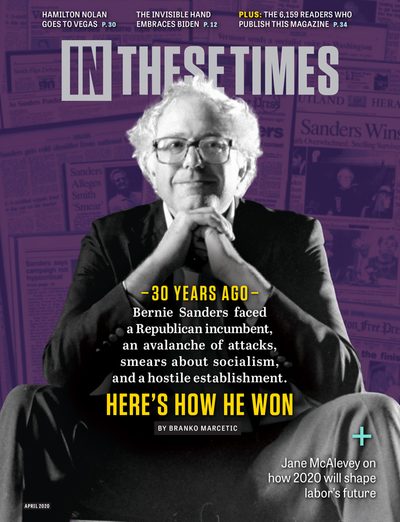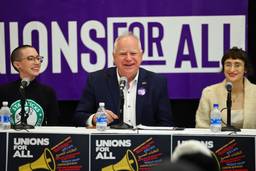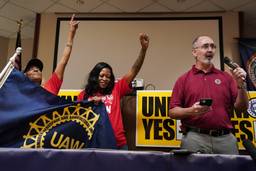Jane McAlevey: We Desperately Need a Mass Strike Against the Billionaire Class
An interview about politics and power.
Mindy Isser

Jane McAlevey died on Sunday, July 7, 2024. We are reposting this Q&A between Mindy Isser and McAlevey from 2020 because it shows McAlevey’s passion for supporting working people and taking down the billionaire class.
The Democratic presidential primary is becoming a pitched battle between the interests of workers and billionaires — the type of fight that Jane McAlevey knows well. The author of A Collective Bargain: Unions, Organizing, and the Fight for Democracy, McAlevey has focused her career as a labor organizer, writer and educator on how to build power — and how to win. In light of the current class struggle shaping up inside (and outside) the primary, her thoughts on how to make strategic interventions are a breath of fresh air.
McAlevey’s book argues that workers must once again wield their most powerful tool: the strike. She believes the strike can empower workers not just in the workplace, but could tip the balance of political power back into the hands of the working class.
In These Times spoke with McAlevey in February (before the coronavirus outbreak became a global pandemic) about how the union movement can energize a fight around the 2020 election, prepare itself regardless of the outcome, and seize new opportunities to build power.
Q: How do you think unions should interact with the next administration, in three possible scenarios: Trump, Joe Biden and Bernie?
JM: If it’s Trump, it’s war. Any union left having a residual concern about what it means to strike if Trump becomes the president again needs to be taken out to the woodshed. He’s already taken us back to the 1960s in terms of the progress we’ve made. There’s going to be nothing left of the country if unions don’t unleash the biggest firepower in the history of the universe against a second Trump administration.
If it’s Biden, unions would have to fight like hell to get anything. Not that Biden is an ideological enemy out to kill unions — that’s the good news — but from all the evidence we have from his years as VP, there’s no evidence he would champion union causes. Labor unions under the Obama administration were simply not a priority — specifically, there was no understanding of how important it was to organize the working class. We can assume Biden would make decent appointments to the NLRB, and we can hope they wouldn’t happen at the very end of his term, but that’s the most we would get without a fight. The multiracial working class cannot afford a Democratic administration that doesn’t make it a central priority to relieve the misery among workers, and to expand the union base that can make that happen.
If it’s Sanders, it’s actually much more tricky for the progressive movement. The error in judgment that we make historically, which is what we did with Obama, is to be hands-off. There’s no room for hands-off. Franklin D. Roosevelt won, and more than a million workers went on strike. What I learned from 1199 New England, an SEIU healthcare union, is that the minute the election’s over — if and when our candidate wins — the very first thing we have to do is pick an intentional fight, to teach them that they work for us. I have never lost that lesson.
For example, Sanders just made a commitment to Unite Here that he would not pass a Medicare for All plan that went backward on any of their pre-existing negotiated benefits. But let’s say he walks in and says, “I’m just going to try to do everything all at once.” The truth is, decisions and priorities will need to be made because that’s the nature of policymaking. So the question is, where do you draw the line? Even with a totally terrific elected official, I envision strong disagreements about where compromises get made. I believe the movement should not back down and have the kid gloves or hands-off approach, just because they’re excited about him.
Q: During the 2016 presidential election, voter turnout was at a 20-year low — about 55%. A big reason is that working people feel like voting doesn’t matter, that nothing in their lives will improve. How do you think we can best fight futility and really frame the choice for voters around the 2020 election?
JM: What’s working in Bernie Sanders’ favor right now is the same thing that worked, frankly, in Obama’s favor, which is that Sanders is really different, something the Democratic Party continues to not understand. People ask why Obama voters went to Trump, but it’s really not that complicated: People are desperate. And anyone who seems different from the mainstream bullshit served out by the Democratic National Committee for the last 30 years in this country is someone who workers are going to take a shot at.
If the party doesn’t screw Sanders and screw the country by locking him out at a brokered convention, we won’t be facing the same futility problem. Sanders has credibility. Trust makes people participate and engage — that’s as true in a union election and a strike vote and a march on the boss as it is with the biggest march on the boss ever: getting Trump out of office. If it’s Sanders, which is who it should be if we stand a chance to win, then people will actually participate. The futility challenge is going to be extraordinary if we have a candidate who is not Bernie Sanders.
One major point I’m trying to get across in the new book is that, no matter who wins the presidency, I don’t think there’s any way out of the mess we’re in without a return to mass strikes. What has really separated Sanders from Elizabeth Warren is his consistent articulation that it’s going to take a giant movement in the streets to move any serious agenda. Warren is obsessed with policy; Bernie is obsessed with the movement he wants to build.
Whether or not it’s a President Sanders in this country, let alone a President Trump, it’s going to require an enormous ability for workers to stand up for themselves and strike. The return of the strike weapon is going to be the single most effective thing we can do, period. It rebuilds social solidarity in really radical ways, and we need it to combat the attack on culture and society launched by Silicon Valley. Working-class people are actually challenging the billionaire class by the level and rate of their contributions to the Sanders campaign. For a lot of people, they almost view voting for Sanders as the first act of their mass strike against the billionaire class, but I think it’s going to have to be significantly increased no matter what.
The most important challenge of our work as organizers in any field is reconstructing the human solidarity that’s being dulled down by the elite. A good union campaign does it like nothing I’ve ever experienced, and a good political campaign can do it, too. When workers come together collectively to do something and they win, it builds extraordinary solidarity, whether it’s to vote against a shitty president or take control from their boss. Every person has to wake up in the morning and write at the top of their daily todo list, how am I building human solidarity today, every day? That’s our work.
Q: Were unions smart to withhold endorsements in the Democratic primary, or did they waste an opportunity? And how did their rank-and-file engagement in the decision compare with 2016?
JM: I would argue that the position holders in the national unions didn’t just wake up and think, “Hey, let’s not be so stupid and endorse Hillary Clinton, or her equivalent, in 2020,” but it was because there was a very serious rank-and-file pushback against the politics of 2016. Many local leaders and workers expressed through their locals how frustrated they were by that top-down decision-making process.
I want to give credit to rank-and-file workers for putting the heat on the position holders in their unions to stave off ill-advised early endorsements. I think no endorsements at the national level is better than early endorsements for a bad candidate. On the other hand, what would impress the hell out of me is if a bunch of unions had woken up today and decided to support Bernie Sanders, and to put the wind in his sails — to have the national unions say, “We’re going to go for it, and actually ride a wave behind the most pro-union candidate in my lifetime, and take a gamble. And the reason why we should take a gamble is because the planet is burning the fuck down.” All organizers know how to create a sense of urgency, but for position holders in the labor movement to currently be standing outside of the political process is a mistake. It’s a travesty, frankly, that most national unions are missing the boat in a profound way.
Internal democracy was marginally better this time, and especially better in the education unions. Thanks to the education workers who have gone on strike and challenged their national position holders, rank-and-file voices are not left out of the decision. Since 2016, rank-and-file members of both the national education unions have pushed for motions at their national conventions that demanded more rank-and-file participation in the political endorsement process. I wish that, in every single union in this country, the rank-and-file were taking control of the endorsement process.
Q: Besides engaging in presidential elections, are there any new avenues opening up for workers to seize power in 2020 and 2021?
JM: If you look at the logistics sector, we’ve got Walmart and Amazon, where just-in-time production is supreme. Walking off the job would drive Jeff Bezos and the Walton family into the ground. I believe good organizing can help people learn how to do this work — there are so many choke points and all of them have basically been ignored by the trade union movement.
Right now, the sort facilities cannot yet use robots for many of the fast delivery services, because consumers are ordering things that are different sizes that aren’t yet containerized — people order an iron and a pack of pens and a roll of toilet paper. What really did damage to the International Longshore and Warehouse Union was containerization, because suddenly a robot machine could lift a container that was filled with lots of different things. Right now, we’re in this sweet spot where the “we deliver your shit the next day” is not containerized. People in the logistics sector could just turn the engine off the Amazon Prime truck, or every driver gets a flat tire on their first turn because Americans learn to do what Latin Americans did, which is take a board, put a bunch of nails in it and let someone run over it. During their strike in 2006, teachers and their supporters in Oaxaca did this. Low-tech tools can stop this shit.
Warehouses, sorting facilities and drivers are the three choke points that — if all of those workers figured out how to build solidarity in key markets — could actually stop Bezos in a real way. Workers in the sorting facilities and in the warehouses in the logistics sector need to become a very important part of the work we’re all doing, along with the education and healthcare sectors. We need the whole community to understand the strategic front is the workplace, and that capitalists don’t care about you unless you stop them from making money.
It is a huge undertaking, but this is where prioritization and strategy come in. I think our movement doesn’t do nearly enough of that because it’s hard to make choices. The one thing I really believe is that, no matter who is in office, anything shy of a continued and really massive increase in the number of workers walking off the job is not enough.
That’s why I keep harping on the need for a serious increase in the use of super-majority strikes in key strategic industries in key strategic labor markets, no matter who walks into the White House, given how pushed back on our heels the working class is in this country.









